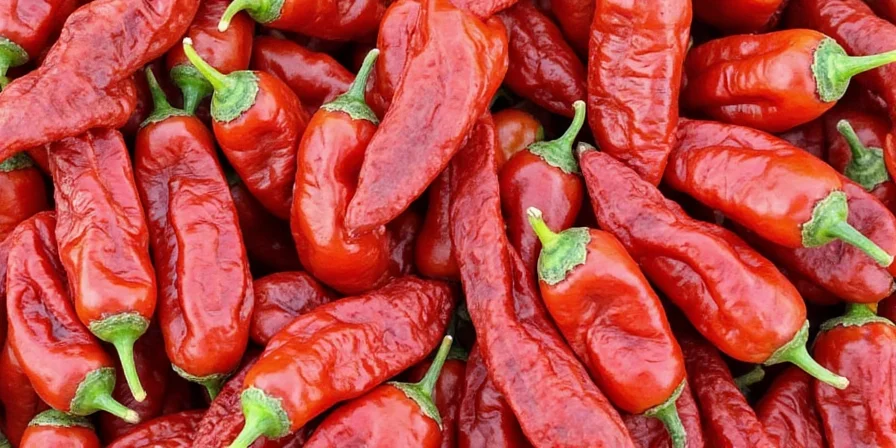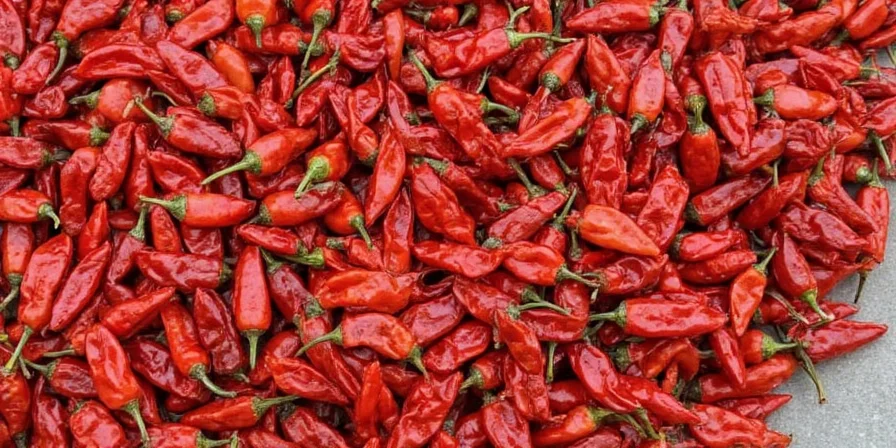What Are Dried Guajillo Peppers?
Dried guajillo peppers are sun-dried mirasol chili peppers ( Capsicum annuum ) with a distinctive deep red color, mild to moderate heat (2,500-5,000 Scoville Heat Units), and complex flavor profile featuring sweet, fruity notes with earthy undertones. As the second most commonly used chili in Mexican cuisine after anchos, they're essential for authentic salsas, moles, and marinades. Unlike hotter chilies, guajillos deliver nuanced flavor without overwhelming heat, making them versatile for both novice and experienced cooks seeking authentic Mexican flavors.
Table of Contents
- What Exactly Is a Guajillo Pepper?
- Flavor Profile: What Makes It Special
- Heat Level and Scoville Scale Explained
- How to Use Guajillo Peppers in Cooking
- Drying and Storage Best Practices
- Proper Rehydration Techniques
- Top 5 Authentic Recipes
- Best Spice Pairings for Guajillo
- Common Mistakes to Avoid
- Frequently Asked Questions
What Exactly Is a Guajillo Pepper?

Guajillo peppers are medium-length chili peppers harvested when red and then sun-dried. The name "guajillo" (meaning "little gourd") comes from the rattling sound dried seeds make when shaken.
Origins and Culinary Significance
Native to Mexico and used since pre-Hispanic times, guajillos are fundamental to regional dishes across Central and Northern Mexico. They're particularly valued in Zacatecas, Jalisco, and Aguascalientes cuisines where volcanic soil enhances their distinctive berry-like notes. Unlike many chilies that primarily add heat, guajillos contribute complex flavor dimensions essential for authentic mole sauces, enchilada sauces, and adobos.
Flavor Profile: What Makes It Special
| Chili | Flavor Notes | Best For |
|---|---|---|
| Guajillo | Sweet, fruity, smoky, cranberry-like | Sauces, moles, marinades |
| Ancho | Earthy, raisin-like, mild | Mole poblano, stews |
| Pasilla | Grassy, prune-like, slightly bitter | Dark sauces, soups |
Understanding Guajillo's Unique Taste
Guajillo peppers offer a distinctive flavor evolution during cooking that sets them apart from other dried chilies. When properly prepared, they deliver bright, almost citrusy fruit notes that deepen into complex earthy tones as they simmer. This dynamic transformation makes them ideal for layered sauces where flavor development matters more than heat intensity. The berry-like undertones (reminiscent of dark cherries or cranberries) pair exceptionally well with chocolate in moles and balance beautifully with acidic ingredients like tomatoes.
Heat Level and Scoville Scale Explained

Guajillo peppers register between 2,500 to 5,000 SHU on the Scoville scale, placing them in the mild to moderate heat range—comparable to poblano peppers but milder than jalapeños (2,500-8,000 SHU). Their heat profile is notably smoother and less sharp than many other chilies.
Practical Heat Guidance
- You can safely use 4-6 whole guajillos in a standard sauce recipe without overwhelming heat
- Heat concentrates in seeds and membranes—remove these for milder flavor
- Peppers from Puebla's volcanic regions tend toward the higher end of the heat spectrum
- Guajillos' heat develops slowly during cooking, unlike instant-heat chilies like cayenne
How to Use Guajillo Peppers in Cooking

Professional chefs rely on these preparation methods to maximize guajillo's flavor potential in authentic Mexican dishes.
Essential Preparation Techniques
- Dry Toasting: Heat a dry skillet over medium heat, toast whole peppers 15-30 seconds per side until fragrant but not burnt. This step is crucial for developing flavor complexity.
- Stem and Seed Removal: Cut open peppers, remove stems and seeds (unless extra heat is desired), then shake out loose seeds.
- Rehydration: Cover with boiling water and steep 20-30 minutes. Reserve soaking liquid for sauces—it contains valuable flavor compounds.
- Blending: Blend rehydrated peppers with soaking liquid until completely smooth. Strain through fine mesh sieve for restaurant-quality texture.
Drying and Storage Best Practices
Maximizing Shelf Life
- Store in airtight glass containers away from light and heat sources
- Include food-safe silica gel packets to absorb moisture
- For long-term storage (6-12 months), vacuum-seal and freeze
- Check periodically for moisture or mold—discard if either appears
- Freshness test: Properly stored guajillos should snap cleanly when bent
Proper Rehydration Techniques
Correct rehydration unlocks guajillo's full flavor potential while preventing bitterness—a common issue when preparing dried chilies.
Professional Rehydration Method
- Remove stems and shake out loose seeds (keep seeds only if wanting extra heat)
- Place peppers in a non-reactive bowl (glass or stainless steel)
- Pour enough boiling water to completely submerge peppers
- Place a small plate on top to keep peppers submerged
- Cover and steep exactly 25 minutes (timing is critical—too long causes bitterness)
- Drain, reserving 1/4 cup soaking liquid for sauces
- Blend with small amount of soaking liquid until completely smooth
Top 5 Authentic Recipes Featuring Guajillo Peppers
- Classic Guajillo Salsa – Blend 6 rehydrated guajillos with 2 garlic cloves, 1/4 onion, 1/2 cup reserved soaking liquid, salt. Simmer 10 minutes. Perfect for tacos and enchiladas.
- Mole Colorado – The "red mole" featuring guajillo as the primary chili, combined with tomatoes, spices, and a touch of chocolate for depth (not sweetness).
- Guajillo-Marinated Skirt Steak – Combine blended guajillo sauce with orange juice, cumin, and garlic for tender, flavorful carne asada.
- Authentic Enchilada Sauce – Simmer rehydrated guajillo puree with chicken broth, cumin, and Mexican oregano for restaurant-quality results.
- Guajillo Chile Con Queso – Blend mild guajillo sauce with melted Oaxaca cheese for a sophisticated, flavorful dip.
Best Spice Pairings for Guajillo Peppers
| Complementary Ingredient | Flavor Enhancement | Recommended Ratio |
|---|---|---|
| Ground Cumin | Amplifies earthy notes without overpowering | 1/4 tsp per 4 peppers |
| Mexican Oregano | Boosts herbal complexity | 1/2 tsp per 4 peppers |
| Garlic | Adds savory depth | 2 cloves per 4 peppers |
| Unsweetened Chocolate | Enhances fruit notes in moles | 1 oz per 6 peppers |
Common Mistakes to Avoid with Guajillo Peppers
- Over-toasting: Just 30 seconds per side is enough—burnt peppers turn bitter
- Incorrect soaking time: 25 minutes is optimal; longer causes bitterness
- Skipping straining: Unstrained sauce has unpleasant texture from pepper skins
- Using cold water for rehydration: Boiling water extracts flavor compounds properly
- Substituting with similar-looking chilies: California peppers lack guajillo's complexity
Frequently Asked Questions
How long do dried guajillo peppers last?
Properly stored in an airtight container away from light and moisture, dried guajillo peppers maintain peak quality for 6-12 months. For extended freshness, vacuum-seal and freeze. Test freshness by bending—a fresh guajillo should snap cleanly rather than bend.
Can I substitute guajillo peppers with another chili?
Ancho peppers are the closest substitute for mild heat and earthy notes, but you'll miss the distinctive berry undertones. For a closer approximation, combine 3 parts ancho with 1 part pasilla. California peppers (chile california) are not suitable substitutes as they're milder and lack complexity.
Why does my guajillo sauce taste bitter?
Bitterness typically results from over-soaking (more than 30 minutes), using water that's not hot enough, or including too many seeds. Always remove seeds completely, use boiling water, and time soaking precisely for 25 minutes. If already bitter, add 1/4 teaspoon of honey or a small piece of plantain while simmering to balance flavors.
Are guajillo peppers the same as California peppers?
No. While sometimes confused, California peppers (chile california) are milder and fruitier, typically used fresh. Guajillos are dried mirasol peppers with a more complex profile. California peppers lack guajillo's distinctive berry notes and are significantly milder (500-1,000 SHU vs. 2,500-5,000 SHU).
Where can I buy authentic dried guajillo peppers?
Look for pliable peppers with deep red color and no signs of moisture. Authentic guajillos should have a faint fruity aroma. Best sources include Mexican grocery stores, reputable online spice retailers, or specialty Latin American markets. Avoid peppers that are brittle (over-dried) or have dull color (old stock).
Final Thoughts
Dried guajillo peppers offer an unmatched combination of mild heat and complex flavor that's essential for authentic Mexican cooking. Their distinctive sweet-earthy profile with subtle berry notes makes them versatile across sauces, marinades, and moles. By following proper preparation techniques—particularly precise toasting, timed rehydration, and seed management—you'll consistently achieve balanced, professional-quality results. Whether you're making traditional mole or experimenting with fusion dishes, guajillos provide the foundational flavor that transforms ordinary dishes into authentic culinary experiences.











 浙公网安备
33010002000092号
浙公网安备
33010002000092号 浙B2-20120091-4
浙B2-20120091-4